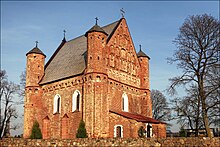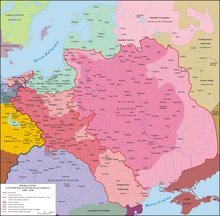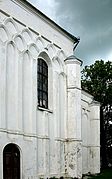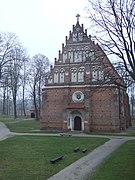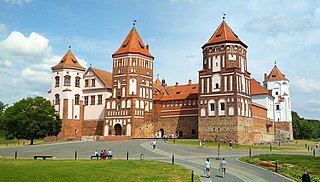
Grodno Region or Hrodna Region, also known as Grodno Oblast or Hrodna Voblasts, is one of the regions of Belarus. It is located in the western part of the country. Its administrative center, Grodno, is also the largest city in the region.

Polotsk or Polatsk is a town in Vitebsk Region, Belarus. It is situated on the Dvina River and serves as the administrative center of Polotsk District. Polotsk is served by Polotsk Airport and Borovitsy air base. As of 2023, it has a population of 79,960.

Novogrudok or Navahrudak is a town in Grodno Region, Belarus. It serves as the administrative center of Novogrudok District. As of 2023, it has a population of 28,021.
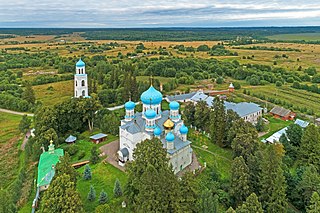
An onion dome is a dome whose shape resembles an onion. Such domes are often larger in diameter than the tholobate (drum) upon which they sit, and their height usually exceeds their width. They taper smoothly upwards to a point.

Nyasvizh or Nesvizh is a town in Minsk Region, Belarus. It serves as the administrative centre of Nyasvizh District. Nyasvizh is the site of Nesvizh Castle, a World Heritage Site. In 2009, its population was 14,300. As of 2023, it has a population of 15,907.

The Old Town of Vilnius, one of the largest surviving medieval old towns in Northern Europe, has an area of 3.59 square kilometres. It encompasses 74 quarters, with 70 streets and lanes numbering 1487 buildings with a total floor area of 1,497,000 square meters. It was founded by the Lithuanian Grand Duke and King of Poland Jogaila in 1387 on the Magdeburg rights the oldest part of the Lithuanian capital of Vilnius, it had been developed over the course of many centuries, and has been shaped by the city's history and a constantly changing cultural influence. It is a place where some of Europe's greatest architectural styles—gothic, renaissance, baroque and neoclassical—stand side by side and complement each other. There are many Catholic, Lutheran and Orthodox churches, residential houses, cultural and architectural monuments, museums in the Old Town.

The Cathedral of the Theotokos in Vilnius is the episcopal see of the Russian Orthodox Diocese of Lithuania.
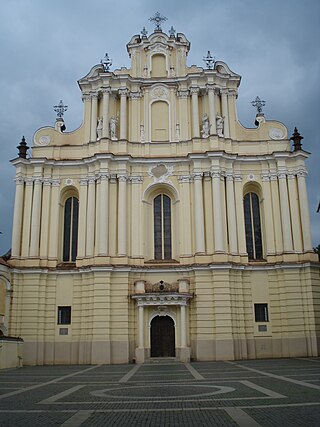
Johann Christoph Glaubitz was an architect of German descent who is generally considered to be the most prominent Baroque architect in the lands of the former Grand Duchy of Lithuania.

The Church of St. Michael is an Eastern Orthodox church on the northern outskirts of the village of Synkavichy, Zelva District, Hrodna Province, in Belarus. It is an example of the Belarusian Gothic and one of the first fortified churches in the Grand Duchy of Lithuania along with the Church of the Nativity of the Blessed Virgin Mary in Muravanka.

Vasil Zacharka was a Belarusian statesman and the second president of the Belarusian People's Republic in exile.

Taraškievica or Belarusian Classical Orthography is a variant of orthography of the Belarusian language, based on the literary norm of the modern Belarusian language, the first normalization of which was made by Branislaŭ Taraškievič in 1918, and was in official use in Belarus until the Belarusian orthography reform of 1933. Since 1933, Taraškievica has been used informally in Belarus and by the Belarusian diaspora abroad. In a more common sense Taraškievica is sometimes considered to be a linguistic norm.
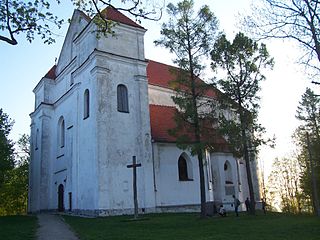
The Transfiguration Roman Catholic Church in Novogrudok, Belarus, is a Baroque church erected in 1712–1723, replacing an earlier Gothic building from the late 14th century, and originally consecrated under the title of Corpus Christi. Two Gothic chapels survive and are included in the Baroque building.
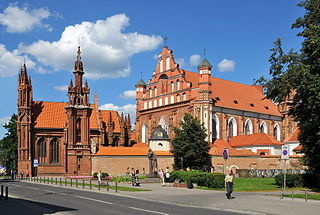
Lithuania is not the very centre of Gothic architecture, but it provides a number of examples, partly very different and some quite unique.
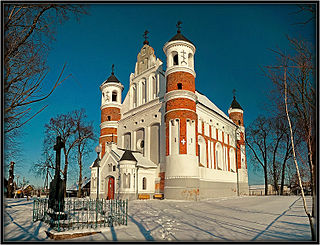
Church of the Nativity of the God's Mother is an Eastern Orthodox church in Muravanka, Shchuchyn District, Hrodna Province, in Belarus. It is an example of the Belarusian Gothic and one of the first fortified churches in the Grand Duchy of Lithuania along with the Church of St. Michael in Synkavichy.
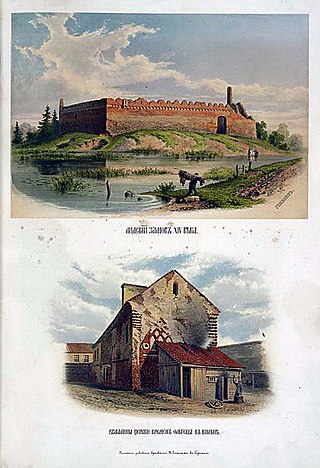
Vasiliy Vasilievich Griaznov was a Belarusian painter, art teacher and architectural historian.

The architecture of Belarus spans a variety of historical periods and styles and reflects the complex history, geography, religion and identity of the country. Several buildings in Belarus have been designated as UNESCO World Heritage Sites in recognition of their cultural heritage, and others have been placed on the tentative list.

Batlejka is a Belarusian amateur puppet theatre. Its name is derived from the city of Bethlehem and performances are traditionally given over the Christmas period.

The Church of the Holy Trinity is a Roman Catholic church in Hyervyaty, Grodno Region, Belarus. It is an example of the Belarusian Neogothic architecture and was built in 1899–1903. The church is a site of cultural heritage of Belarus.
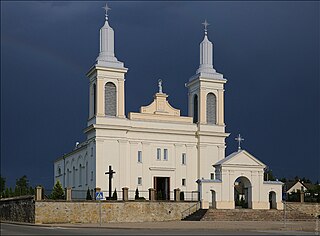
The Church of Saint Wenceslaus in Vawkavysk is a Belarusian Catholic church in the Grodno Region. Constructed in 1846–1848, it is now listed as a Belarusian national cultural heritage object.
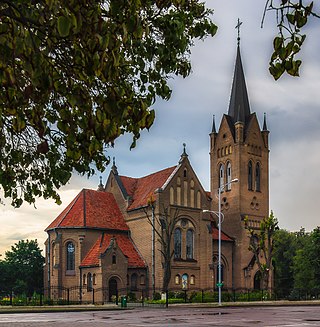
Church of the Exaltation of the Holy Cross is a Catholic church in Vileyka, Belarus. Built between 1906 and 1913, it is now listed as a Belarusian Cultural Heritage object.
